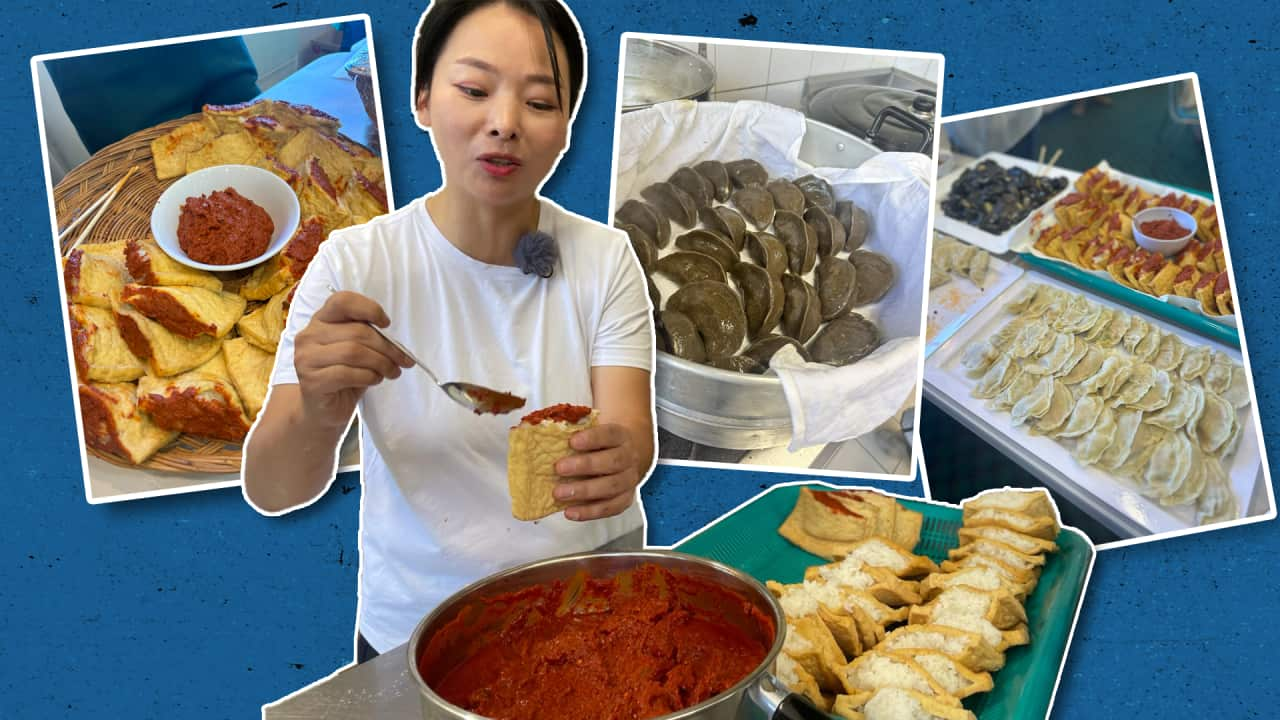Key Points
- North Korean food was at the centre of a rare cultural exchange event in Sydney.
- Eight North Korean defectors and their families met with around 60 South Korean migrants.
- Kumyoung Choi, 42, a North Korean defector turned businesswoman, was the driving force behind the event.
As they can be prepared in minutes, cornmeal cakes are known as sokdojeon tteok, which means ‘speed cakes’, in North Korea.

Kumyoung Choi makes cornmeal cakes, known as sokdojeon tteok, which means ‘speed cakes’, in North Korea. Source: SBS / Laszlo Mizsak
The dish also brings up painful memories for Kumyoung.
“Once, a friend of mine told me her wish was to eat a piece of cornmeal cake, and she passed away the very next day. She starved to death,” she said.
A meeting of North and South
It was hosted by the Australian branch of the Peaceful Unification Advisory Council (PUAC), a policy advisory organisation for the South Korean government.

A rare gathering of North Korean defectors and South Korean migrants was held in Sydney. Source: SBS / Leah Hyein Na
According to the latest Census, there are around 80 registered North Korean-born individuals residing in Australia.
Kumyoung claimed the event represented the largest gathering of North Koreans ever in Australia.
“Koreans living here are surprised when they see people who have defected from North Korea. Mostly it’s their first time seeing us.”
Sharing experiences through food

North Korean defectors based in Australia make potato rice cakes. Source: SBS / Edwina Guinan
While South Korean cuisine enjoys great popularity around the world, food from the north is less known.
North Korean blood sausages, known as sundae, use glutinous rice and vegetables, which give them a light and delicate flavour compared to the South Korean version made with sweet potato noodles.

Kumyoung Choi and Kyungok Cho make North Korean blood sausages, known as sundae, using glutinous rice and vegetables. Source: SBS / Edwina Guinan
Based in Sydney, Kyungok Cho learned these recipes while working in the commercial kitchen of a large restaurant in Pyongyang before escaping in 2004.
“These were precious dishes, so we couldn’t even make them at home. They were only for special occasions. We sometimes bought them in markets,” she said.

North Korean dumplings, blood sausages and tofu rice (left), frozen potato rice cakes (top right) and cornmeal cakes (bottom right). Source: SBS / Leah Hyein Na
Perilous journey
Four years later, after failed attempts to reach South Korea and amid heightened police surveillance, they were on the move again.

Kumyoung Choi (bottom right) photographed with her grandmother, parents and four siblings in North Korea. Source: Supplied / Kumyoung Choi
Upon entering Myanmar, Kumyoung’s parents and three siblings were arrested, while Kumyoung managed to evade capture by hiding.
“They even called me halmeoni (grandmother in Korean). It was disheartening to see my reflection in the mirror,” she said.

Kumyoung fled North Korea in 1997 and arrived in South Korea in 2001 after enduring immense hardships. Source: Supplied / Kumgyoung Choi
Discovering discrimination
After arriving in Seoul in 2001, Kumyoung’s expectations of a new life were quickly dampened
.
“A professor in my university once asked me if I was a spy. I fled from North Korea because I was hungry, so I cried a lot when I heard that.”

Professor Bronwen Dalton, a North Korean expert at the University of Technology Sydney, said “often North Koreans are treated with a degree of distrust from South Koreans”. Source: SBS
Professor Bronwen Dalton, a North Korean expert at the University of Technology Sydney, said “often North Koreans are treated with a degree of distrust from South Koreans”.
“When I told people I fled from North Korea, they accepted my story beautifully and respected me.”

Now, Kumyoung runs eight restaurants on the Sunshine Coast. Source: SBS / Laszlo Mizsak
Mentoring other North Korean defectors
“I knew that I would be happy only if everyone around me and who knew me was happy,” she said.

Kwangjin Lee, who came to Australia last year with Kumyoung’s help, said such events are important to bring people together. Source: SBS / Laszlo Mizsak
Kwangjin Lee, who came to Australia last year with Kumyoung’s help, said such events are important to bring people together.
“Personally, I think it was very meaningful as people like me from North Korea were able to be part of the Korean community.”
‘Reunification starts with the people’
During the event, children from North and South Korean families came together to sing a song of peace: “Just as flowers bloom in the North and flowers bloom in the South, they are flowers. They are flowers, no matter where they bloom.”

Children from North and South Korean families sing a song of peace. Source: SBS / Leah Hyein Na
While such lyrics convey an optimistic outlook, Dalton said opportunities for building relationships between North and South Korea are rare and may become even rarer.
He called for South Korea to be classified as North Korea’s “primary foe” in a speech to the Supreme People’s Assembly, his country’s rubber-stamp parliament.

Ryde City Councillor Daniel Han, a member of the South Korean community, said it was a rare chance to have honest conversations. Source: SBS / Laszlo Mizsak
Ryde City Councillor Daniel Han, a member of the South Korean community, participated in the event and said it was a rare chance to have honest conversations.
“It is probably the only opportunity for the North and South people to meet freely in Australia. And this is where the reunification can start, from the people, with understanding and without any prejudice from each other,” he said.

Eight North Korean defectors and their families based in Australia gathered in Sydney. Source: SBS / Leah Hyein Na
